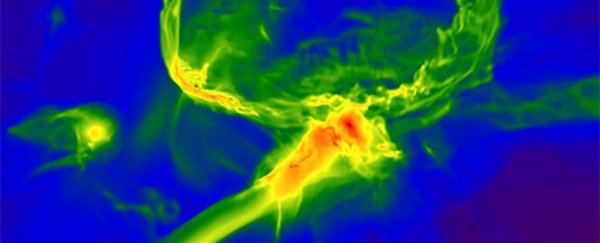An ancient gas cloud located billions of light-years away from Earth may contain remnants of the very first stars that formed in the Universe, according to a new study.
Researchers led by Swinburne University of Technology in Australia observed the gas cloud as it was some 1.8 billion years after the Big Bang, using Chile's Very Large Telescope. The gas cloud shows an extremely small percentage of heavy elements – such as carbon, oxygen and iron – suggesting that what the scientists have found is extraordinarily old.
"Heavy elements weren't manufactured during the Big Bang, they were made later by stars," said Neil Crighton from Swinburne's Centre for Astrophysics and Supercomputing. "The first stars were made from completely pristine gas, and astronomers think they formed quite differently from stars today."
Shortly after these first stars – called Population III stars – formed, they exploded in powerful supernovae that spread heavy elements into surrounding clouds of pristine gas. According to the researchers, the chemical record of such gas clouds can be read like a fingerprint, indicating just how ancient they really are.
"Previous gas clouds found by astronomers show a higher enrichment level of heavy elements, so they were probably polluted by more recent generations of stars, obscuring any signature from the first stars," said Crighton.
In contrast, the gas cloud discovered by Crighton and his colleagues contains only very faint traces of heavy elements, suggesting a possible fit for evidence of the death of the first stars.
"This is the first cloud to show the tiny heavy element fraction expected for a cloud enriched only by the first stars," said one of the team, Michael Murphy.
If they're right – which nobody knows for sure just yet – it's a big deal, but in any case the ratio of elements involved here could help researchers look for other similar ancient gas clouds that might be comparable relics from the very early Universe.
"We can measure the ratio of two elements in this cloud – carbon and silicon. But the value of that ratio doesn't conclusively show that it was enriched by the first stars; later enrichment by older generations of stars is also possible," said study co-author John O'Meara from Saint Michael's College in Vermont. "By finding new clouds where we can detect more elements, we will be able to test for the unique pattern of abundances we expect for enrichment by the first stars."
The findings were recently presented at a meeting of the American Astronomical Society and are reported in Monthly Notices of the Royal Astronomical Society Letters.
Swinburne University of Technology is a sponsor of ScienceAlert. Find out more about their innovative research.
